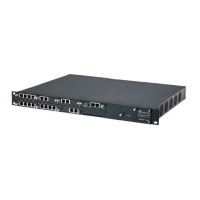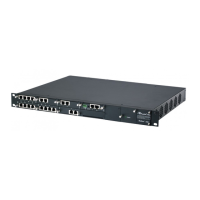User's Manual 454 Document #: LTRT-27055
Mediant 1000B Gateway & E-SBC
Parameter Description
[1] Enable (default)
Note:
Digital interfaces: To interwork the Hold/Retrieve supplementary
service from SIP to ISDN (QSIG and Euro ISDN), set the
EnableHold2ISDN parameter to 1.
Analog interfaces: To use the call hold service, the devices at
both ends must support this option.
The corresponding global parameter is EnableHold.
Add IE In Setup
add-ie-in-setup
[IpProfile_AddIEInSetup]
Defines an optional Information Element (IE) data (in hex format)
which is added to ISDN Setup messages. For example, to add IE
'0x20,0x02,0x00,0xe1', enter the value "200200e1".
Note:
The parameter is applicable only to digital interfaces.
The IE is sent from the Trunk Group IDs configured by the
SendIEonTG parameter .
You can configure different IE data for Trunk Groups by
configuring the parameter for different IP Profiles and then
assigning the required IP Profile in the IP-to-Tel Routing table
(PSTNPrefix).
The feature is similar to that of the EnableISDNTunnelingIP2Tel
parameter. If both parameters are configured, the
EnableISDNTunnelingIP2Tel parameter takes precedence.
The corresponding global parameter is AddIEinSetup.
QSIG Tunneling
enable-qsig-tunneling
[IpProfile_EnableQSIGTunneli
ng]
Enables QSIG tunneling-over-SIP for this SIP entity. This is
according to IETF Internet-Draft draft-elwell-sipping-qsig-tunnel-03
and ECMA-355 and ETSI TS 102 345.
[0] Disable (default).
[1] Enable = Enables QSIG tunneling from QSIG to SIP, and vice
versa. All QSIG messages are sent as raw data in corresponding
SIP messages using a dedicated message body.
Note:
The parameter is applicable only to digital interfaces.
QSIG tunneling must be enabled on originating and terminating
devices.
To enable this function, set the ISDNDuplicateQ931BuffMode
parameter to 128 (i.e., duplicate all messages).
To define the format of encapsulated QSIG messages, use the
QSIGTunnelingMode parameter.
Tunneling according to ECMA-355 is applicable to all ISDN
variants (in addition to the QSIG protocol).
For more information on QSIG tunneling, see QSIG Tunneling on
page 494.
The corresponding global parameter is EnableQSIGTunneling.
Copy Destination Number to
Redirect Number
copy-dst-to-redirect-number
[IpProfile_CopyDest2Redirect
Number]
Enables the device to copy the called number, received in the SIP
INVITE message, to the redirect number in the outgoing Q.931
Setup message, for IP-to-Tel calls. Thus, even if there is no SIP
Diversion or History header in the incoming INVITE message, the
outgoing Q.931 Setup message will contain a redirect number.
[0] Disable (default).

